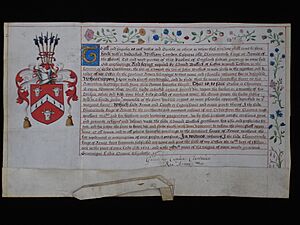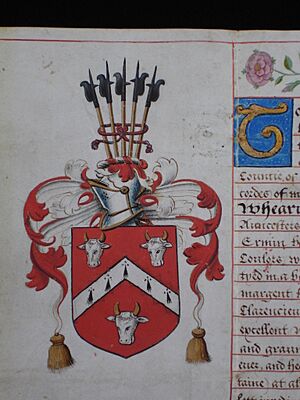Sir Edward Bullock facts for kids
Sir Edward Bullock of Faulkbourne (born around 1580, died 1644) was an important English landowner. He was given the title of Knight by King James I. Sir Edward was a well-known member of the Bullock family and owned Faulkbourne Hall in Essex, England.
Contents
Sir Edward's Life Story
Edward Bullock was born around 1580. He was the older son of Edward Bullock from Wigborough and Loftes, and Joan Collen from High Laver, Essex.
In 1602, Sir Edward received official approval for his family's coat of arms (a special symbol for a family) from William Camden, a royal expert on such things. On July 3, 1609, King James I made him a Knight at Richmond Palace. From 1613 to 1618, he was a Captain in the local army (Militia) for the Maldon area.
Helping the King
When King Charles I first became king, Sir Edward was asked to help collect a special "Forced Loan" in County of Norfolk. This was a way for the King to raise money, but it was very unpopular with many people. Sir Edward lived in Pentney at the time (around 1622-1631). His records show that he paid £1,200 into the King's treasury. These forced loans caused a lot of tension between the King and Parliament.
Legal Challenges
In 1630, Sir Edward had some disagreements over land with his neighbors in Norfolk. This led to a legal case in 1633 before a special court called the Star Chamber. He was sent to prison in London for a short time because of this.
By 1635, he was free and living in London. At this time, King Charles I had made a rule that important people should leave London and go back to their country homes to help with local duties. Many people, including Sir Edward, did not follow this rule. They were then taken to the Star Chamber court for not obeying the King's order. The King wanted nobles and gentry to be in their local areas to help govern, but many people found this rule difficult.
Faulkbourne Hall
Sir Edward Bullock lived at Loftes for most of his life. However, in 1637, he bought the large estate of Faulkbourne. From 1637 until 1897, Faulkbourne Hall was the main home for the Bullock family.
English Civil War and His Death
As the English Civil War was about to begin, a man named William Poe complained to Parliament in May 1642. He said that Sir Edward Bullock had unfairly kept him in prison, even though the Star Chamber court (which had put him there) had been closed down. Poe then joined the Parliamentary Army as a Captain. He was active in Essex, which might explain why Sir Edward Bullock later had problems with the Parliamentarians.
Even though Sir Edward Bullock did not fight in the war, his family strongly supported the King (they were Royalists). When the war ended in 1644, Parliament ordered him to pay a fine of £300. However, Sir Edward died in the same year. So, his son had to deal with the fine. After nine years, two-thirds of the fine was eventually cancelled.
Sir Edward Bullock died in 1644 and was buried at St Germanus' Church, Faulkbourne. Because of his public duties and spending, some of his other estates, like Loftes, Little Mapelstead, and Finchingfield, had to be sold after his death. His wife moved to Clerkenwell, where her house was attacked by soldiers in March 1644.
Family Life
Sir Edward Bullock married Elizabeth. She was the daughter of Thomas Wylde of Glazeley Hall and Kempsey. Elizabeth was also the sister of Sir Edmund Wylde. Edward and Elizabeth had one son, also named Edward. This younger Edward married Mary, the daughter of Sir William de Grey.
See also
- Bullock family
- Faulkbourne Hall



